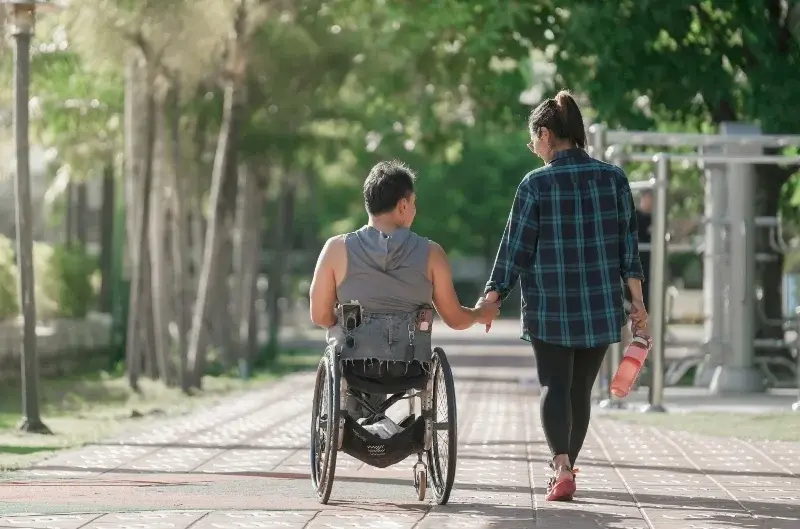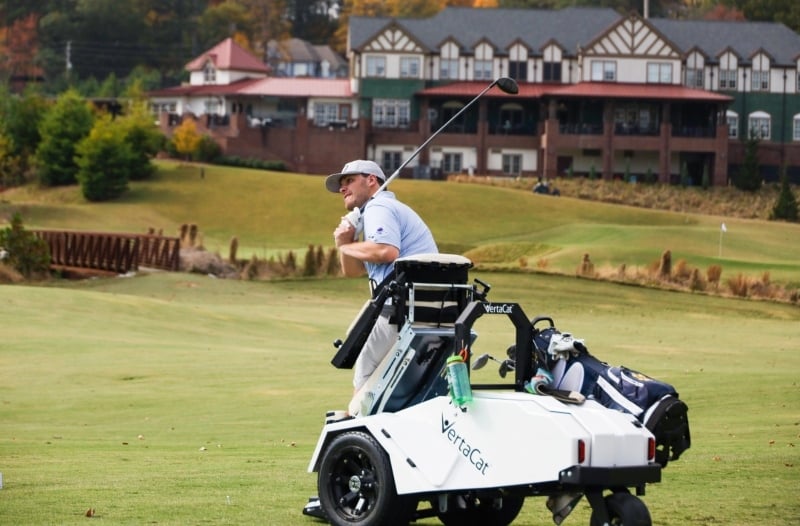Back in the Game: Skylar Miller's VertaCat Story
Skylar Miller golfed his entire life. Then, a spinal cord tumor changed everything.
5 min read
VertaCat Apr 25, 2025 1:00:00 PM

Golf has a way of changing lives. Connections established, bonds renewed, families united. Not even paralysis can stop people from playing the game they love—if they have the means to do so.
Getting those means is the tricky part for many adaptive families.
If you have a golf-obsessed adaptive loved one, you already know the look in their eyes when they talk about the game. That wistful gaze toward the window, remembering days spent on fairways with friends. They may think the game they love is beyond reach.
Mobility challenges entered your lives, and many things have changed—but their passion for golf hasn't. You can help them find their way back to the course.
This guide will walk you through understanding adaptive golf equipment, not just as technical devices, but as keys that unlock independence, joy, and renewed purpose.
When someone loses mobility, they lose pieces of their identity. They lose the simple freedom to enjoy their favorite activities without a second thought.
You've witnessed this firsthand–the frustration, the grief, the withdrawal.
Finding golf again means fully addressing that grief. Choosing equipment that works is the first step, but you’re ultimately working to restore dignity and normalcy to their lives. You’re giving them the chance to stand shoulder-to-shoulder with friends again, experience the satisfaction of a well-struck ball, and reclaim their ability to join random rounds on Saturday mornings.
Your role in this journey is irreplaceable. You know their history with the game. You understand their specific challenges. You can advocate for their needs in ways no one else can. Your support transforms what could be an overwhelming process into a shared adventure, helping them rediscover something they thought might be lost forever.
Before you research anything, have an honest talk with your loved one. Don’t make it a big deal, just ask: "What do you miss most about golf?"
They might care more about the social connection, the competitive challenge, being outdoors, or perhaps the simple satisfaction of improvement. This can help you better understand their needs.
Next, ask them about their hopes and hesitations. What would returning to golf mean to them? What fears do they have about using adaptive equipment? They might worry about looking “different” on the course or slowing down play. They might question if adaptive golf will feel "real" enough. Validate their feelings and address the emotional aspects of this transition together.
Also, try talking to their healthcare providers about returning to golf. Ask about weight-bearing restrictions, balance considerations, and any movements to avoid. This helps you better evaluate equipment options. Remember that doctors see the medical perspective, but you understand the whole person—their spirit, determination, and what brings them joy.
Many devices qualify as “adaptive golf equipment,” ranging from simple accessories to sophisticated mobility devices. Each serves different needs and offers unique benefits, but “stand-up” equipment options, like the VertaCat, can make the game even more accessible.
Stand-up technology has changed how adaptive people play, mostly by making the experience seem natural. On the VertaCat, it enables players who can’t stand to swing from a standing position. It also allows players to look at their playing partners at eye level, not from below.
Unlike standard wheelchairs or scooters that would struggle with golf course terrain, the VertaCat’s advanced adaptive equipment handles slopes up to 17 degrees, meaning they can dig themselves out of the messiest patches of rough.
With a reliable, long-lasting battery, a person can play an entire round of golf without constantly checking the charge level. Multiple speed settings allow the unit to match the pace of able-bodied players while also providing the control needed to navigate carefully around lies on the green.
Imagine them playing a full round without their body screaming at them. That's what true comfort brings. Adjustable seating in adaptive equipment means freedom from the pain that cuts joy short. It means staying out there with their friends, feeling good, not constantly reminded of limitations.
And getting in and out easily? That's huge. It means not having to rely on others, and holding onto their independence. It's the confidence of knowing they can handle themselves, the relief of not feeling like a burden. It's about focusing on the game, the camaraderie, the sheer pleasure of being on the course—not the struggle to participate.
You want your loved one to be out there, swinging and laughing, not constantly on edge. That's what real safety with adaptive equipment delivers–confidence. Knowing this equipment is built strong, that it won't tip or wobble on tricky ground. It's about feeling secure enough to forget about the equipment and focus on their shot.
The controls should feel like they're part of them, responding instantly, not some clunky machine to fight with. Having slower speeds for tight spots (and faster ones for open spaces) fosters control.
Ultimately, it's about freedom: the freedom to enjoy the game without a knot of worry in their stomach.
Evaluating adaptive golf equipment can be a tricky process. Don't just look at the fancy lists—dig deeper and imagine them being out on the course. Ask the questions that reveal the real story.
These questions aren't just about specs; they're about ensuring joy, independence, and ease–for everyone involved.
No need to avoid the financial considerations in your evaluation. It’s worth understanding the cost. But you’re not just buying a piece of equipment. You're investing in a chance for your loved one to re-experience things they might be missing right now. It's a ticket back to life, to connection, to feeling like themselves again.
Don't feel like you're alone in this. There are ways to make this happen. Look into local nonprofit organizations for grant opportunities.
And don't underestimate the power of community with local golf clubs and online fundraising. People want to help when they understand what this truly means. Let your loved one share their story, let them share the joy that returning to golf will bring. This isn't just about getting equipment; it's about giving them back a piece of their life.
Bringing your loved one back to golf can rebuild their self-assurance. That effect will ripple through every part of their life. You're working to keep those cherished family moments intact, refusing to let limitations take them away. You're showing everyone that while things might need to be done differently, their passions don't have to disappear.
Your dedication teaches everyone around you about perseverance and finding creative solutions to challenges. And the joy you help them rediscover reminds us all that adapting is about finding new paths to what truly matters.
When you see them on that first tee again, ready to swing, reconnected with a game they love, you'll understand the true impact. This was about restoring possibility, independence, and pure joy—one thoughtful step, one swing, one adaptive solution at a time.
Take the first step toward helping your loved one rediscover the freedom of golf.

Skylar Miller golfed his entire life. Then, a spinal cord tumor changed everything.
.jpg)
At The Loop Golf Course in Chaska, Minnesota, adaptive access was baked into the blueprint. Today, three VertaCats serve golfers who travel from...

The Minnesota Golf Association (MGA) hosted Minnesota’s first Adaptive Open in September at Braemar Golf Course in Edina. The three-day event...